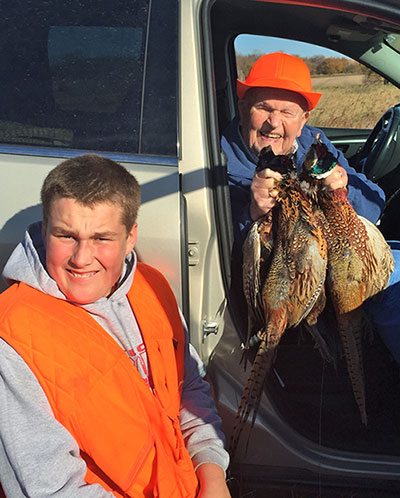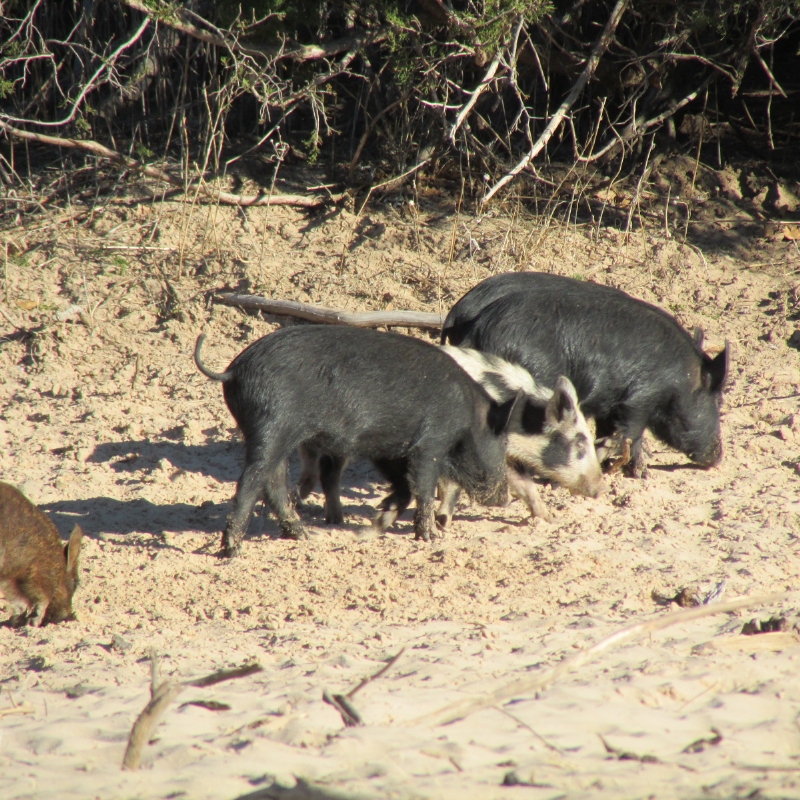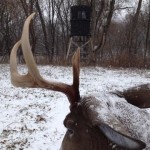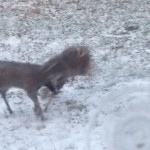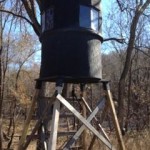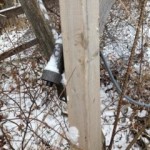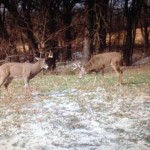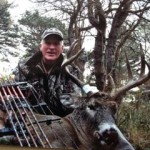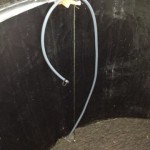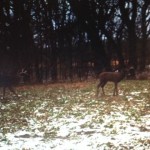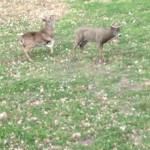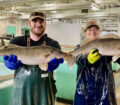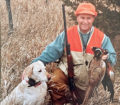by Clark Schmitz
Over many years of bow hunting whitetails, one thing I can count on, certain- things will change. Good or bad, no two hunting seasons will be the same. Ever changing deer patterns, weather conditions, neighbor’s livestock / pets, and food sources result in the need to be flexible in your hunting tactics.
I‘ve enjoyed using deer decoys off and on for a long time and find it fascinating how differently each deer may react to the decoy. The use of a life sized deer decoy is definitely a two edged sword. It may put a deer right in your lap, totally focused on the decoy, or send it packing to parts unknown.
Generally, younger deer readily accept the decoy as the real deal, just as a younger deer may tolerate a hunter’s mistakes, such as: movement, scent, or sounds. Mature bucks however are more cautious and need a little more convincing that the decoy (a deer he doesn’t recognize) is in fact real, and a threat to his territory and more importantly his does.
In preparing for the 2014 Iowa archery deer season, I set up a stand sight that would augment the use of a decoy. An enclosed tower blind, positioned on the edge of a clover food plot would be the location. This setting was important as it’s best the deer first see the decoy from longer distances. When deer first notice the decoy at close range they tend to react with extreme caution.
In the past I had experimented with different decoys and even tried covering a decoy with a tanned deer hide. I studied the latest commercially made decoys and purchased what looked to me to be a very realistic product.
Next I wanted to be able to add some movement to the decoy. In years past it seemed that the lack of movement could make a mature deer nervous. It was also very surprising how close a deer may get to the decoy before even noticing it. Some movement would really help with these concerns. The enclosed tower blind would allow me to create movement at the decoy discreetly. I attached an eyelet to the rear leg of the decoy, drilled a hole in the bottom of the blind and attached guides to the tower stand so a small cord could be run from the decoy right at ground level to the very bottom of the tower stand, and up into the blind. When set up, the decoy was held in place with a rod that was located between the front legs. With even a small pull of the tightly stretched cord attached to the rear leg of the decoy, a noticeable movement of the head was achieved.
Next was a more realistic sound. A ground grunter was used to position a grunt call at “deer height” on the tower stand. Although some distance from the decoy, I felt the call not coming from the enclosed elevated blind had to help. The overall set up looked good.
Rut finally arrived and I started using the new decoy set. On Nov. 11, I arrived at the stand well before first light to set up the decoy, attached the movement cord and spray the decoy with a scent eliminating product. At first light two does came into the food plot and surprisingly, fed close to the decoy as others had done on earlier hunts. I have had far more negative reactions than positive ones from does when decoying in the past. At approx. 10:00 am a doe followed by an 8 pt. buck with a broken G2, (a fighter), entered the food plot. He bristled up, postured and without hesitation began walking stiff legged toward the decoy. I decided not to attempt a shot at this deer and instead reached for my camera as he was putting on quite a show. Just as I was taking his picture, the buck lowered his shoulder and charged the decoy sending it flying and landing eight feet from its original position. The buck circled and stopped 40 yards from the decoy and stared at the now horizontal decoy lying on the ground with antlers and ears scattered about! After a minute of stomping and snorting, the buck left. I climbed down and put the decoy back together with the only real damage being a broken antler. The decoy would have to be a 1 antlered buck for now. This removal of 1 antler is considered by some avid decoyer’s as a way to position the approaching buck, as he may be encouraged to approach at the weak, non-antlered side. I have found many deer that approach the decoy will actually go to the rear of the decoy, and almost touch it in an effort to smell it.
As does came into the food plot I would experiment with the motion cord attached to the decoy. It seemed to relax some while further excite others. Other bucks that came in were consistently posturing and showing true aggression. The movement seemed more useful when the deer were at a greater distance. The ground grunter also seemed to be working although with the rut in full swing most bucks that were within reasonable distance of the decoy needed little encouragement to come in to check out this unwelcome visitor.
The next day, Nov 12, I was back in the blind well before light. The morning was filled with good deer movement. Several does came to the food plot and investigated the decoy. Some with more caution than others. A decent 8 pt, came aggressively to the decoy for the second day in a row. At noon I decided to again stay on stand all day as the deer movement was quite good. At 3pm the first deer of the afternoon showed up, a doe feeding in the corn field to the north 125 yards. Later a small 6 pt cut across the food plot, but was obviously wanting no trouble with the decoy and skirted well around it. At approx. 4:30pm I looked behind the small black curtain, used to darken the blind, on the south side of the blind and noticed a doe and good buck coming towards the decoy set up. Replacing the curtain, I then slowly opened the windows facing the decoy. I removed my bow from its hanger and waited for the buck to appear west of the blind. Nervous seconds passed as I wondered if the deer had hung up, not sure about the decoy. Finally the bristled up buck came into view walking stiff legged and posturing. Slowly he continued towards the decoy. At 10 yards from the decoy and quartered away, I slowly drew back, picked a spot, and watched as the arrow hit the deer behind the shoulder. The buck immediately bolted, but ran only 20 yards before stopping and glaring at the decoy. The deer obviously thought the decoy had somehow caused the “jab” felt when the arrow hit. The buck stood motionless for several seconds before slowly walking a short distance and going down.
This time the decoy had worked perfectly, putting the buck in a good shooting position with his focus totally on the decoy. The buck coming in to the decoy, all bristled up, ready to fight, added a great deal of excitement to the hunt. The next time however may be totally different. A super buck may be coming directly towards my stand site, see the decoy and spook out of the area, making me wish I had left the decoy at home.
What a dilemma!
- Decoy’s view of blind
- Buck charging decoy
- Elevated Blind
- Grunt call mounted on blind stand
- Buck challenging decoy
- Buck Harvested
- Decoy movement cord and remote grunt call tube in blind
- Buck harvested coming in to decoy
- Buck reacting negatively to decoy

